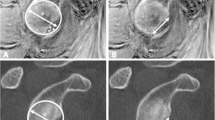Abstract
Objective
To evaluate the diagnostic yield of two acquisitions of single-contrast CT arthrography (CTA) of the shoulder in internal, neutral, or external glenohumeral rotation with arthroscopic correlation.
Materials and methods
The CT study was obtained using two acquisitions (first the humerus positioned in maximum tolerated external rotation with the arm along the body and the second with the humerus in internal rotation with the palm placed flat on the table). Two independent readers blinded to the arthroscopic results evaluated the CTA images for labral tears, glenoid bone loss/fractures, and cartilage loss. For each CTA acquisition, sensitivity and specificity for detection of the aforementioned pathology were assessed. Inter-reader agreement was quantified by weighted ĸ statistics.
Results
Sensitivity and specificity for detecting anteroinferior or posterior labral tears was highest with neutral rotation (sensitivity 91–100%, specificity 61–100%). For glenoid fracture, sensitivity (67%) was highest with external rotation and specificity (100%) was highest with internal rotation. For cartilage loss, sensitivity (64%) and specificity (89%) was highest with external rotation and neutral rotation, respectively. Neutral rotation showed high sensitivity and specificity for glenoid fractures and cartilage loss. Inter-reader agreement ranged from fair to very good.
Conclusions
Neutral glenohumeral position in shoulder CT arthrography was adequately sensitive and specific for the detection of intra-articular pathology, avoiding the use of more than one acquisition.







Similar content being viewed by others
References
Krøner K, Lind T, Jensen J. The epidemiology of shoulder dislocations. Arch Orthop Trauma Surg. 1989;108(5):288–90.
Rhee R, Chan K, Lieu J, Kim B, Steinbach L. MR and CT arthrography of the shoulder. Semin Musculoskelet Radiol. 2012;16(1):3–14.
Resnik CS, Deutsch AL, Resnick D, et al. Arthrotomography of the shoulder. Radiographics. 1984;4(6):963–76.
Singson RD, Feldman F, Bigliani L. CT arthrographic patterns in recurrent glenohumeral instability. AJR Am J Roentgenol. 1987;149(4):749–53.
Shuman WP, Kilcoyne RF, Matsen FA, Rogers JV, Mack LA. Double-contrast computed tomography of the glenoid labrum. AJR Am J Roentgenol. 1983;141(3):581–4.
Rafii M, Firooznia H, Golimbu C, Minkoff J, Bonamo J. CT arthrography of capsular structures of the shoulder. AJR Am J Roentgenol. 1986;146(2):361–7.
Haynor DR, Shuman WP. Double contrast CT arthrography of the glenoid labrum and shoulder girdle. Radiographics. 1984;4(3):411–21.
Kim YJ, Choi J-A, Oh JH, Hwang SI, Hong SH, Kang HS. Superior labral anteroposterior tears: accuracy and interobserver reliability of multidetector CT arthrography for diagnosis. Radiology. 2011;260(1):207–15.
Deutsch AL, Resnick D, Mink JH, et al. Computed and conventional arthrotomography of the glenohumeral joint: normal anatomy and clinical experience. Radiology. 1984;153(3):603–9.
Waldt S, Metz S, Burkart A, et al. Variants of the superior labrum and labro-bicipital complex: a comparative study of shoulder specimens using MR arthrography, multi-slice CT arthrography and anatomical dissection. Eur Radiol. 2005;16(2):451–8.
De Maeseneer M, Van Roy F, Lenchik L, et al. CT and MR arthrography of the normal and pathologic anterosuperior labrum and labral-bicipital complex. Radiographics. 2000;20 Spec No:S67–81.
Rafii M, Firooznia H, Bonamo JJ, Minkoff J, Golimbu C. Athlete shoulder injuries: CT arthrographic findings. Radiology. 1987;162(2):559–64.
Pennes DR, Jonsson K, Buckwalter K, Braunstein E, Blasier R, Wojtys E. Computed arthrotomography of the shoulder: comparison of examinations made with internal and external rotation of the humerus. AJR Am J Roentgenol. 1989;153(5):1017–9.
Coumas JM, Waite RJ, Goss TP, Ferrari DA, Kanzaria PK, Pappas AM. CT and MR evaluation of the labral capsular ligamentous complex of the shoulder. AJR Am J Roentgenol. 1992;158(3):591–7.
Chodick G, Ronckers CM, Shalev V, Ron E. Excess lifetime cancer mortality risk attributable to radiation exposure from computed tomography examinations in children. Isr Med Assoc J. 2007;9(8):584–7.
Muratore CS. Pediatric abdominal CT scans: do it correctly. Better yet, don’t do it at all. J Surg Res. 2013;185(2):533–53417.
Pearce MS, Salotti JA, Little MP, et al. Radiation exposure from CT scans in childhood and subsequent risk of leukaemia and brain tumours: a retrospective cohort study. Lancet. 2012;380(9840):499–505.
Baysson H, Etard C, Brisse HJ, Bernier M-O. Expositions radiologiques à visée diagnostique pendant l’enfance et risque de cancer: bilan des connaissances et perspectives. Arch Pediatr. 2012;19(1):64–73.
Sodickson A, Baeyens PF, Andriole KP, et al. Recurrent CT, cumulative radiation exposure, and associated radiation-induced cancer risks from CT of adults. Radiology. 2009;251(1):175–84.
Smith-Bindman R, Lipson J, Marcus R, et al. Radiation dose associated with common computed tomography examinations and the associated lifetime attributable risk of cancer. Arch Intern Med. 2009;169(22):2078–86.
Berrington de González A, Mahesh M, Kim K, et al. Projected cancer risks from computed tomographic scans performed in the united states in 2007. Arch Intern Med. 2009;169(22):2071–7.
Davis SJ, Teresi LM, Bradley WG, Ressler JA, Eto RT. Effect of arm rotation on MR imaging of the rotator cuff. Radiology. 1991;181(1):265–8.
Landis JR, Koch GG. The measurement of observer agreement for categorical data. Biometrics. 1977;33:159–74.
Jim YF, Chang CY, Chang T. Shoulder computed arthrotomography: role of internal and external rotation. Zhonghua Yi Xue Za Zhi (Taipei). 1992;50(2):108–13.
Author information
Authors and Affiliations
Corresponding author
Ethics declarations
Funding
None.
Conflict of interest
The authors declare that they have no conflicts of interest.
Ethical approval
All procedures performed in studies involving human participants were in accordance with the ethical standards of the institutional and/or national research committee and with the 1964 Helsinki Declaration and its later amendments or comparable ethical standards.
Informed consent
Informed consent was waived for individual participants included in the study. The study was approved by the local Institutional Review Board (IRB) and HIPAA compliant.
Rights and permissions
About this article
Cite this article
Simeone, F.J., Gill, C.M., Taneja, A.K. et al. Glenohumeral position during CT arthrography with arthroscopic correlation: optimization of diagnostic yield. Skeletal Radiol 46, 769–776 (2017). https://doi.org/10.1007/s00256-017-2613-x
Received:
Revised:
Accepted:
Published:
Issue Date:
DOI: https://doi.org/10.1007/s00256-017-2613-x




